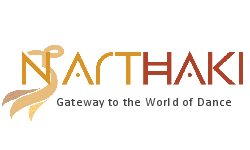
|   |

|   |
An evening at NCPA with 'Rama Amritam' and 'Viraasat' - Chandra Anand e-mail: chandra6267@yahoo.co.in Photos courtesy: NCPA June 5, 2025 At Experimental Theatre, NCPA, Mumbai on May 15, 2025, Sujatha Ramanathan presented "Rama Amritam", a solo presentation, where the story of Rama, which is always beautiful to hear, "bhavyasuguna ramam", was brought out through classical dance styles of Bharatanatyam, Bharata Nrityam and theatrical expansiveness. Concept, choreography and direction was by Sujatha Ramanathan. The performance was on recorded music where giving excellent support were - Raghuram Rajagopalan on vocals, DV Prasanna Kumar on nattuvangam, Satish Krishnamoorthy on mridangam and ganjira, and Prashanth Rudrapatna on veena and that day on light management was Sushant Jadhav. 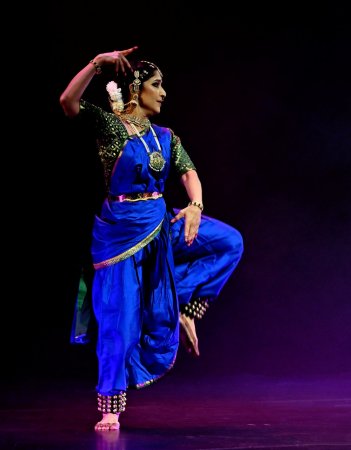 Sujatha Ramanathan The presentation commenced segueing gracefully to a Mallari in which elements of the Alarippu and use of the padmakosa hasta appeared prominently. The theme of Rama was suitably introduced by highlighting the name "Rama", which has resonance of both Lord Vishnu and Lord Shiva. Sujatha deftly performed to a brief recitation of sollukattu displaying Nandi, the bull, with Shiva riding on him and chronicled the famous verse "Sriraama raama raameti rame raame manorame sahasranaama tattulyam raama naama varaanane", from the Vishnu Sahasranamam, which is equal to reciting the 1000 names of Lord Vishnu, thus conveying the deep message of spiritual import of chanting the "Rama Nama" which benefits all. Going forward with "Tumaku chalatu Ramachandra", the famous bhajan composed by Tulsidas, the sheer delight of imagining and seeing Rama as a toddler crawling, walking and attempting to run was showcased. The joy of mother Kaushalya enjoying her son by holding him and playing with him in various ways was a joy to see. Thus one experienced vatsalya rasa atop the glimpse of the divine in human form. "Ramam ravikulaambudhi somam" (Mohanakalyani, Rupakam), a keertanam by P.S. Krishnamoorthy was performed as a main piece in the presentation where the attributes of Lord Rama was glorified. Rama was shown shining like the sun in his valor and also cool and composed like the moon while bestowing his graces. A jathi was performed in the beginning and korvais were performed to the chittaswarams aptly composed for choreographing korvais. The nritta choreography suited the tempo and poise of the song, covered the stage and ended with well-defined teermanam korvais. The stories of Jatayu moksham and Vali damanam were displayed with great histrionic skills. In fact, credit goes to Sujatha for conveying the whole episode of Jatayu fighting to save Sita getting kidnapped by Ravana with only the depiction of Jatayu's forceful actions. The Karuna rasa poured out as one saw Rama honoring Jatayu with a dignified farewell. A short thillana completed the presentation with finesse. Each moment shone with intensity of expression and liveliness. It held the audience enraptured and worthy of time spent. 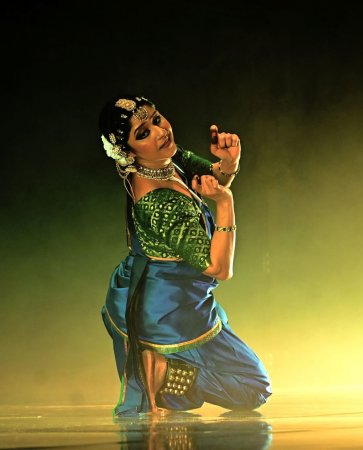 Sujatha Ramanathan An evocative performance with layers of thoughts processed to give a different approach to the oft repeated concept was acknowledged by many. The movements light and heavy, either of nritta and nritya, or of human and animal characters had been very well thought out. The presentation offered something for everyone to take away with them in their hearts. An in-depth idea of how Sujatha Ramanathan processed her ideas in the presentation can be gleaned from a small interview session with her. So what is your new approach to this oft repeated concept of Ramayana? When I introspected on the importance of Rama among the avatars of Maha Vishnu, and that Mahadev himself considered Rama to be superior became the whole thread in the approach. References of this idea of Lord Rama's greatness are found in the Kamba Ramayana, the Vishnu Sahasranama and the Ramcharitamanas. How did you think the keertanam "Ramam ravikulambudhi somam" help bring out the essence of your idea of Ramayana? The premise of the keertanam composed by PS Krishnamoorthy Sir is about the "contrasts" which resonates with my narrative. Belonging to the Surya Kulam which is blazing like the sun, Rama gives us that sense of meditation and calmness of the moon. Likewise, he is a respected, valorous warrior prince who is duty bound and yet shows compassion and kindness. These aspects relate to each one of us hence relevant for us to reiterate the lessons that we can learn from Rama himself. The commitment Rama showed towards Sugriva has touched me personally as part of my understanding of Kamba Ramayanam, the verses for which Krishnamoorthy Sir was so forthcoming to add to the composition. How is the narrative relevant to present day context? When I began the process of making "Rama Amritam", I connected to the character, the persona of Rama. There are several life lessons that one can learn and absorb by understanding the character of Rama, and that is the whole purpose of the sacred text itself. Staying committed, performing one's duty and taking ownership, being assertive, resilient to circumstances, having a balanced approach in good times and otherwise are all attributes of a great leader. At the same time, the valour and courage displayed (Vali damanam), the empathy that he demonstrated (Jatayu moksham) make him a complete balanced character. We realize that the Lord has had to face challenges like we do as well and yet has taught us how to deal with them. Hence the relevance not only today but forever. We need to find the spirit of the character in each one of us. 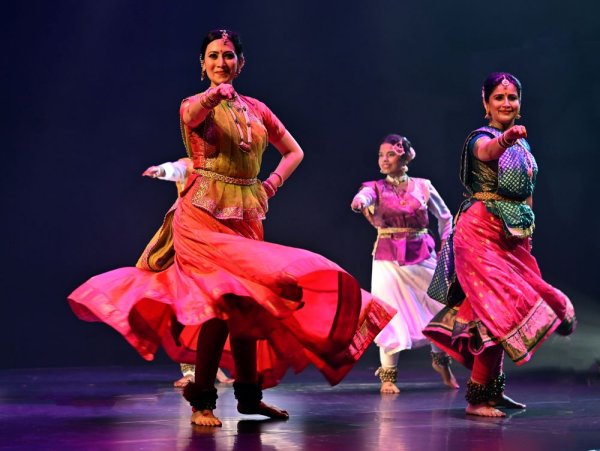 Dr. Parinita Shah and Vaidehi Parashurami with group The second performance that day, 'Viraasat- the journey of Kathak from katha to contemporary' was presented by Dr. Parinita Shah and Vaidehi Parashurami, who are students of Kathak legend Guru Asha Joglekar. Kathak, derived from the Sanskrit word 'katha' the story telling, began as a raw and expressive art form - a medium for narrating tales through movement and rhythm. Ganesh Vandana as a prayer and the story of Narasimha and Sharabh from the Linga Mahapuranam, katha kathan in gat bhav format, was presented. The dance showed the fury of Narasimha after he killed Hiranyakashipu and how Lord Shiva finally came himself as Sharabh to pacify Lord Vishnu. The story was well enacted along with their disciples. Thus, the origin of Kathak in temples, rooted in mythology, and performed as a sacred narrative, bringing epics to life, was clarified. They presented "taal ang" through use of nritta pieces in teen taal. Significant patterns of tatkaars from the Rajput and Mughal courts were presented. The differentiation of the tandav- lasya were brought out through a traditional paran. An example of dancing after reciting bols called padhant and example of Gat nikaas depicting the ched chaad of Radha (Parinita) and Krishna (Vaidehi) were performed, and concluded taal ang with an ashta disha chakri paran. In the taraana, they explained how the local language of India was substituted by gibberish bols to transcend barriers of language. In Mughal courts, repertoires included salaami and aamad (a Persian word meaning aagaman). Short brief intricate pieces performed to showcase the above, shone through with liveliness and energy, gently conveying the gracefulness and expressiveness of the dance form. 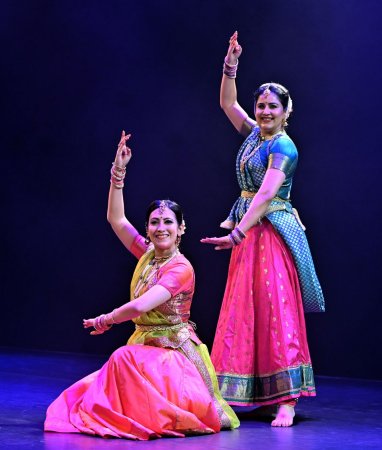 Dr. Parinita Shah and Vaidehi Parashurami Proving that the medium of classical dance of Kathak could be used to present modern time happenings, they ventured to present a thematic presentation "Udaan", wherein the historic achievement of the first rocket launch of India spearheaded by Vikram Sarabhai and Homi Bhaba was captured in a nutshell. The calculations that went into construction of the rocket, the lookout for a place in India - Thumba, building of the rocket, the red tapism they faced were all depicted very smoothly. Along the side of the story line, the art of Kathak known for its footwork, chakri and laykari too was highlighted. Thus Kathak shining brilliantly in present times was verified. The seed of innovation was sowed by their Guru Asha Joglekar who encouraged them to explore various themes giving them wings to make the art form their own. Thus, they gave a beautiful meaning to the word Udaan of going forward with what they acquired from their Guru, by presenting new contemporary happenings and thus bringing modernity within the traditional format. Hats off to Parinita and Vaidehi for they presented Kathak they had inherited, processed and made their own – a dance form that continued to evolve while staying rooted within the traditional framework, bridging tradition with innovation, the past with the present and mythology with modern history. 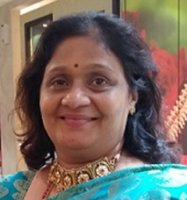 Chandra Anand is a Bharatanatyam artiste and teacher. She has an MA in Bharatanatyam from Tilak Maharashtra Vidyapeeth, and her series on 'Education in spiritual values through Bharatanatyam' is featured in narthaki.com. |